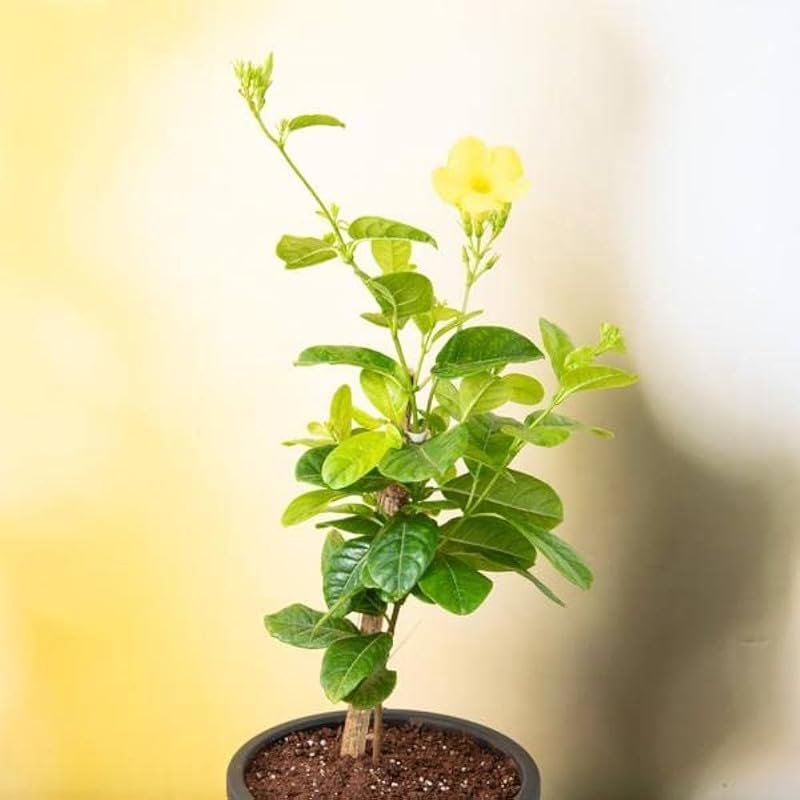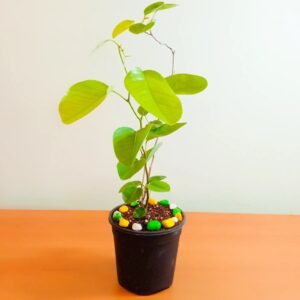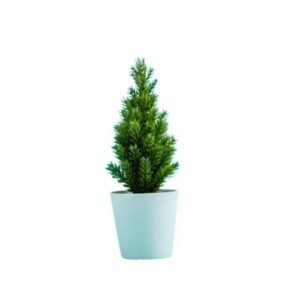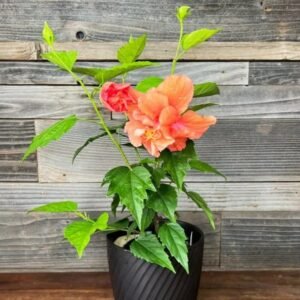Description
Mini Allamanda (Allamanda cathartica ‘Dwarf’)
The Mini Allamanda, scientifically known as Allamanda cathartica ‘Dwarf’, is a compact, tropical flowering shrub prized for its lush green foliage and eye-catching golden-yellow blooms. A scaled-down version of the larger Allamanda cathartica, the mini or dwarf variety has grown increasingly popular in landscaping and home gardening for its neat size, vivid floral display, and low maintenance requirements.
Botanical Classification
- Common Name: Mini Allamanda, Dwarf Allamanda
- Scientific Name: Allamanda cathartica ‘Dwarf’
- Family: Apocynaceae (Dogbane family)
- Origin: Native to South and Central America, particularly Brazil
- Growth Habit: Evergreen, compact shrub
- Type: Perennial in tropical/subtropical zones; often grown as an annual or potted plant in temperate regions
Physical Characteristics
The Mini Allamanda is a compact, bushy plant that typically grows to a height of 1 to 3 feet (30 to 90 cm), with a similar spread. This makes it an excellent choice for smaller gardens, borders, patio containers, and urban landscaping where space is limited.
- Leaves: The leaves are glossy, lance-shaped, and arranged in whorls along the stems. They are medium to dark green in color, providing a rich background that contrasts beautifully with the flowers.
- Flowers: The star attraction of the Mini Allamanda is its bright yellow, trumpet-shaped flowers, which measure about 2 to 3 inches in diameter. These blooms have five fused petals and a flared throat, resembling a golden trumpet or bell. Flowers typically appear from spring through fall, with occasional blooms in winter in warm climates.
- Stems: The stems are woody at the base and become slightly vining, although the dwarf variety generally maintains a more mounded or shrub-like appearance than the vine form of the regular Allamanda.
Growing Conditions and Care
Mini Allamanda is known for being hardy and adaptable when provided with the right conditions. Here are its primary requirements:
- Sunlight: Full sun is essential for optimal flowering. The plant requires at least 6–8 hours of direct sunlight daily to produce its signature blooms. It can tolerate partial shade, but flower production may be significantly reduced.
- Soil: Prefers well-drained, fertile soil. A slightly acidic to neutral pH (6.0–7.0) is ideal. Avoid heavy, clayey soils that retain water, as this may cause root rot.
- Watering: Water regularly, especially during the active growing season (spring and summer). Keep the soil consistently moist but not soggy. Allow the top layer of soil to dry slightly between waterings. Reduce watering in cooler months.
- Temperature: Mini Allamanda thrives in warm, tropical to subtropical climates. The ideal temperature range is 65–85°F (18–30°C). It is not frost-tolerant and should be protected or brought indoors in regions with temperatures below 50°F (10°C).
- Humidity: Prefers high humidity but can tolerate average indoor humidity levels. Misting or using a humidity tray can help in dry indoor environments.
- Fertilization: A balanced, slow-release fertilizer or a liquid bloom-boosting formula (high in phosphorus) applied monthly during the growing season promotes vigorous growth and abundant flowering.
- Pruning: Regular pruning helps maintain a compact shape and encourages branching and more blooms. Prune lightly after each flowering cycle or trim to shape in early spring.
Propagation
Mini Allamanda can be propagated by stem cuttings taken in spring or early summer:
- Take 4–6 inch semi-hardwood cuttings.
- Remove the lower leaves and dip the cut end in rooting hormone.
- Plant in a well-draining mix (perlite and peat or sand).
- Keep warm and moist until roots develop, typically in 4–6 weeks.
Pests and Diseases
The plant is relatively pest-resistant but may occasionally suffer from:
- Aphids: Can be managed with insecticidal soap or neem oil.
- Spider Mites: Especially in dry conditions; increase humidity and spray with water or miticide.
- Mealybugs and Scale: Remove manually or treat with horticultural oil.
- Fungal Issues: Overwatering or poor drainage may cause root rot or leaf spot diseases. Always ensure good air circulation and avoid waterlogging.
Uses and Benefits
Mini Allamanda is as functional as it is beautiful, with a wide range of horticultural and aesthetic applications:
- Landscaping: Ideal for low hedges, foundation plantings, borders, or mass plantings. It can be shaped into a neat mound or allowed to sprawl slightly for a more natural look.
- Containers: Perfect for patio pots, balcony gardens, and entryways. Use a rich, well-drained potting mix and ensure containers have good drainage.
- Tropical Accents: Adds a bold splash of color and a tropical feel to any garden or landscape design.
- Pollinator Attraction: The vibrant yellow flowers attract bees, butterflies, and hummingbirds, contributing to local biodiversity.
Cultural Significance and Symbolism
In some cultures, Allamanda species are associated with positivity, radiance, and happiness due to their cheerful color and long-lasting flowers. While not traditionally a medicinal plant, parts of the Allamanda are used in folk medicine in some regions, though care should be taken, as the sap can be mildly toxic if ingested or if it comes into contact with sensitive skin.
Cautions
Allamanda plants contain mildly toxic latex sap, which may cause skin irritation or gastrointestinal discomfort if ingested in large quantities. Keep out of reach of pets and children, and wear gloves when pruning.
Conclusion
The Mini Allamanda is a delightful, low-maintenance plant that brings color and charm to gardens, balconies, and indoor-outdoor spaces alike. With its brilliant yellow flowers and tidy, compact growth, it’s an excellent choice for both novice and experienced gardeners. Its ability to bloom nearly year-round in warm climates and adapt well to containers makes it a standout in any setting. Whether as a cheerful border plant or a patio showpiece, the Mini Allamanda continues to earn its place as a favorite among tropical ornamental shrubs.







Reviews
There are no reviews yet.